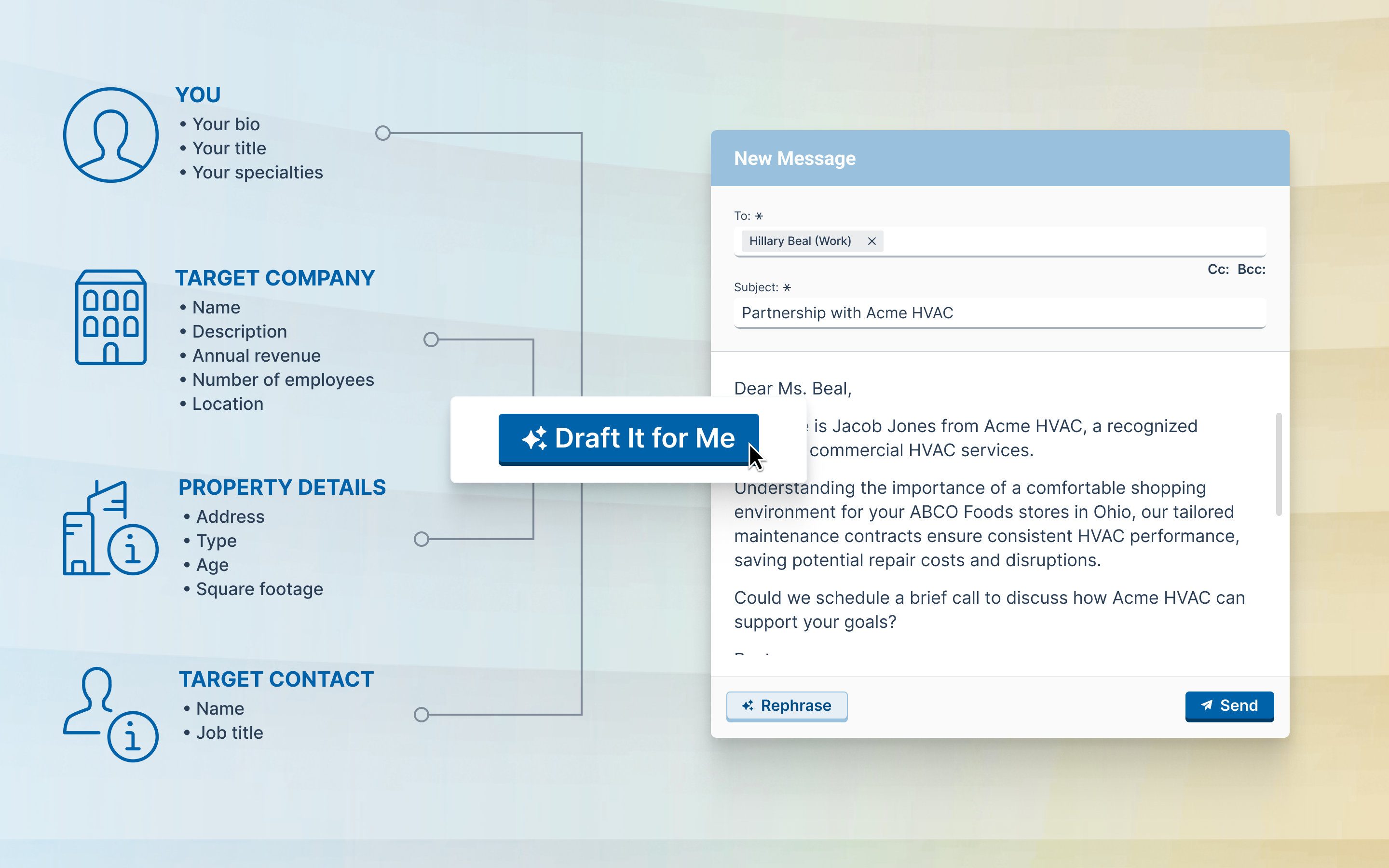Introduction: A Day in the Life of a Pest Control Sales Pro
Picture this: You're looking for local restaurants to sell your services to. On an average morning, you find yourself scrolling through another batch of cold leads from your marketing vendor, knowing that despite paying $15- 35.00 per lead, 90% will never convert. Meanwhile, three blocks away, a restaurant manager is frantically calling pest control companies because a health inspector just found evidence of rodent activity during a surprise visit.
The clock is ticking- they need a solution now, not next week.
This scenario isn't hypothetical. In 2023 alone, over 100 food service locations in the U.S. were cited for rodent health code violations, and a 2022 health study found that 66% of food service establishments surveyed saw rodents in or around the immediate exterior of their building. When these compliance emergencies hit restaurants, business owners don't have time to research all of the local options. They need immediate solutions from vendors who understand their world and can solve their problem.
In this article, we’ll walk you through: how property intelligence transforms your approach from waiting for restaurant pest control leads to find you, to identifying food service prospects when they're actively searching for solutions - often when they’re most open to your services because they actively need help.
Why Traditional Lead Generation Fails for Restaurant Pest Control

The typical advice for generating pest control leads reads like a digital marketing playbook from 2015: optimize your website, build social media presence, collect customer reviews, and wait for the phone to ring. This "pull" approach might work for residential customers planning preventive treatments, but it's fundamentally misaligned with how restaurants actually buy pest control services… and how pest control companies sell.
Here's the reality of the food service market: restaurants operate under constant regulatory pressure. Health departments conduct unannounced inspections, and a single pest sighting can trigger immediate violations, fines, or even temporary closures.
In New York City alone, 2% of all inspections resulted in restaurant closures - nearly 400 establishments. When these situations arise, restaurant managers aren't comparison shopping on Google - they're calling the first reliable vendor they can find.. And their search leaves clues that can help you generate extremely warm leads.
The problem with traditional lead generation in this market is timing.
Pest control violations make up 20% of restaurant health inspection reports, making it a major category that significantly impacts a restaurant's reviews online.
But by the time a negative review shows up on Google, Yelp, or one of the other platforms, they're often past the point of emergency. Their brand is in peril.
Also, by the time negative reviews begin showing up online, they've either already solved the problem or found a vendor through word-of-mouth referrals.
This leaves pest control companies competing for scraps while the real opportunities happen behind closed doors.
Consider the typical restaurant owner's day: They're managing staff schedules, menu creation, food production, food costs, customer complaints, and regulatory compliance. When a potential pest issue arises, they don't have the bandwidth to research five different vendors, read through brochures and marketing materials, and look at online reviews for each vendor.
They need a trusted professional who understands food service compliance and can respond proactively to their needs.
Traditional marketing also fails to account for the seasonal and cyclical nature of restaurant pest challenges. Summer brings increased fly and cockroach activity. Winter drives rodents indoors.
Another factor is that new restaurant openings require preventive treatments before opening. But traditional marketing doesn’t account for these factors.
These patterns create predictable demand cycles that proactive sales teams can anticipate and act on - if they have the right data. This is where property intelligence that’s built for commercial sales teams is a game changer.
What is Property Intelligence?

Property intelligence is a data-driven approach that provides detailed insights about commercial buildings and the businesses operating within them. Unlike traditional lead databases that offer basic contact information, property intelligence platforms combine multiple data sources to create comprehensive profiles of potential prospects and their likely needs.
Now, if I lost you in the industry jargon, here’s a better way to understand it. Think of property intelligence solutions like Convex as having a research assistant who monitors every building in your territory 24/7. This system tracks things like building permits, buyer intent signals (indications that someone is looking for services), ownership changes, and renovation activity.
For pest control sales teams targeting restaurants, this means seeing signals that indicate potential service needs before competitors even know these opportunities exist.
The core difference between property intelligence and traditional lead databases is only fully understood by seeing the depth and actionability of information.
A standard lead list might tell you that Joe's Restaurant exists at a specific address.
Property intelligence tells you that Joe's Restaurant recently pulled permits for kitchen renovations, is actively searching for pest control vendors, and is owned by a management company that operates twelve other locations in your territory.
This is a complete shift from traditional “lead-gen.”
To do this effectively, property intelligence platforms like Convex collect data from multiple sources so that sales teams can see food service needs at the property level.
Building and permit records that show construction activity, renovations, and infrastructure changes that can create pest “entry points” (also known as sales outreach triggers) or disrupt existing treatment schedules.
Buyer Intent Signals that show who’s on location and what they’re actively searching for.
Ownership and management details that help identify decision-makers and connect related properties under the same ownership and management.
These three are all key to sales, but the real power comes from the platform's ability to identify "signals"—behavioral indicators that suggest a property may need pest control services soon.
For pest control professionals, this transforms prospecting from a numbers game into a strategic process. Instead of cold-calling 100 random restaurants, you're reaching out to prospects with specific, timely reasons to need your services.
The Property Intelligence Approach to Restaurant Pest Control Leads
Flipping the Traditional Lead Generation Model
In this way, property intelligence flips the traditional lead generation model on its head. Instead of waiting for restaurant and food services pest control leads to find you, you identify prospects when they're most likely to need services - often before they’ve settled on a vendor and sometimes, before they realize they need your help.
This method of lead generation requires a slight change in your approach, but it pays dividends when you realize the potential impact of using signals to start conversations with warm prospects.
Think about how most teams sell pest control services. You find a list of restaurants, cold call 100 or so per week, try to email as many as possible (if their contact information is available), drop in, and leave business cards with hosts and other front-end staff, and hope that you’ll eventually reach a decision-maker before they decide on another vendor.
Leveraging Built-in Buying Intent Signals
Solutions like Convex empower your team with the tools to accelerate this process. Instead of generating a list of local restaurants, Convex already includes them in a database - and not just restaurants, but almost 6 million commercial buildings across North America.
You can simply outline your territory on the map and see a complete list of commercial properties, filtering for the type that you generally serve.
Instead of making 100 cold calls, the platform already offers built-in buying intent signals that indicate a restaurant may need pest control services. This is key because, unlike residential customers who might delay treatment, restaurants operate under regulatory pressure that creates urgency.
Permit Activity: Your Strongest Sales Signal
The most powerful signal for restaurant prospects (outside of the signals themselves) is permit activity. When a restaurant pulls permits for kitchen renovations, equipment installations, or structural changes, they're creating conditions that disrupt pest habitats.
These disruptions increase pest activity and require updated pest management protocols and treatments.
New restaurant openings represent another high-value opportunity. Every new food service establishment needs a pest management program before opening, and many require ongoing monthly or quarterly service contracts. Property intelligence platforms can identify these opportunities months in advance by tracking new permit activity.
Using Public Inspection Data for Immediate Prospects
While not included in intelligence platforms, Inspection records provide another layer of insight. According to Food Safety News, this health inspection data is publicly accessible and often a great insight into who’s “in the market.”
Health department inspection data, which varies by jurisdiction, can reveal pest-related citations. Restaurants that have recently been cited for issues like "evidence of rodent activity" or "inadequate pest control" are immediate prospects for your services. You'll need to identify the specific websites for your local area to access this information.
Once you have it, you can use the geographic clusters in Convex to find the contact information for owners and managers of these establishments, plus all of the other restaurants in that area - making your sales team more efficient.
This is helpful because restaurants in the same neighborhood often face similar pest pressures due to shared infrastructure, nearby construction, or seasonal factors. When you identify a pest problem at one location, you can proactively reach out to nearby restaurants before they experience similar issues.
This proactive approach also helps with timing your outreach. Rather than calling restaurants during busy service hours, you can plan your prospecting around permit approval dates, signals, or seasonal pest activity patterns. This strategic timing dramatically improves your connection rates and conversation quality.
Strategic Timing and Relevant Messaging
The messaging becomes more relevant, too. Instead of generic cold calls about pest control services, you're offering specific solutions to known challenges. Think about how much better, "I noticed you recently pulled permits for kitchen renovations. Health departments typically require updated pest management protocols for these changes. I'd like to discuss how we can help ensure your reopening goes smoothly…” would convert a prospect into a lead than, “who handles your vendor relationships?”
But Convex goes one step further by building in Generative AI to draft outreach messages and phone call scripts for your team based on property data. Instead of the generic outreach messages, the platform will create relevant outreach messages in one click - increasing the outreach efficiency and potential conversions for your team.

Identifying High-Intent Restaurant Prospects
As we briefly covered in the last section, the key to successful restaurant prospecting lies in recognizing the signals that indicate an immediate or near-term need for pest control services. These signals fall into several categories, each requiring a different approach and timeline.
While it may seem a bit repetitive, building a sales strategy and training your team to identify these signals can be the difference between quotas that are met or even exceeded quarter after quarter and salespeople who get burned out and leave, costing your company money and leaving talent gaps in your business.
These signals are:
Buyer intent data, which identifies restaurant owners and food service managers who are actively seeking pest control services.
Permit and Construction Activity creates the strongest buying signals. When restaurants pull permits for kitchen renovations, HVAC installations, or structural changes, they're creating conditions that disrupt existing pest management systems. New equipment installations often require updated treatment protocols, and construction activity can create new entry points for pests.
The timing here is critical. You want to reach out during the planning phase, not after work is completed. A restaurant planning a kitchen renovation is much more receptive to discussing comprehensive pest management than one that finished renovations six months ago.
New Restaurant Openings represent guaranteed prospects, but the window for engagement is narrow. Every new food service establishment needs a pest management program before opening, and many health departments require pest control certifications as part of the licensing process. The challenge is identifying these opportunities early enough to build relationships with decision-makers before they commit to competitors. Property intelligence platforms can track business license applications, construction permits, and equipment deliveries to identify new restaurants months before they open.
Health Inspection Violations create immediate urgency. The most common pest-related violations include live rodents or insects, pest feces, insect carcasses, and chewed or damaged food packaging. Restaurants cited for pest-related violations face potential fines, closure orders, or license suspensions if they don't address issues quickly. These prospects have moved beyond considering pest control—they need it now. However, timing your outreach requires sensitivity. A restaurant dealing with a health department violation is under stress, so your approach needs to focus on solutions rather than sales. Research shows that around 70% of diners are unwilling to visit restaurants that violate health codes, making swift resolution critical for business survival. "I see you're dealing with some compliance challenges. We specialize in helping restaurants resolve these issues quickly and prevent future problems."
Seasonal Patterns help predict when restaurants will need enhanced services. Summer months bring increased fly and cockroach activity. Fall drives rodents indoors seeking food and shelter. Spring restaurant openings prepare for busy summer seasons. Understanding these patterns helps you plan proactive outreach campaigns rather than reactive responses. Reaching out to restaurants in August about fall rodent prevention is more effective than waiting until they discover mice in their storage areas.
Ownership and Management Changes often trigger reviews of existing service contracts. When restaurant properties change hands or management companies acquire new locations, they typically evaluate all vendor relationships, creating opportunities for new pest control providers.
These triggers for outreach will dramatically increase your sales efficiency, even if you’re not using a solution like Convex, because they identify exactly when a prospect is most likely to need your help. Once identified, relationships can be built on trust and value rather than a salesy cold approach.
While we’d recommend that you use an intelligence solution that can track permits, signals, ownership transfers, management changes, and corporate acquisitions that indicate these vendor review periods, understanding these concepts and helping your team execute them will dramatically improve business performance.
Case Study: How Pye-Barker Fire & Safety Grew 85% Using Compliance-Driven Prospecting

Pye-Barker Fire & Safety operates in another high-stakes compliance market that mirrors pest control perfectly. Like pest control violations, fire safety citations can immediately shut down restaurants and food service establishments. Both industries serve businesses that can't afford to wait when compliance issues arise.
The Challenge: Pye-Barker's sales team was stuck in reactive mode, waiting for calls and struggling to manage a growing team of 16 reps across different experience levels. "The nature of sales is to be out making sales calls, and that can make transparency into their activities difficult," said Nick White, Regional Director of Sales.
The Property Intelligence Solution: Using Convex, Pye-Barker transformed from reactive to proactive prospecting. The platform revealed ownership connections that created immediate opportunities. "I could tell you many success stories about how our team has used Convex to prospect great opportunities, not only at the property in front of them, but simply by calling a phone number listed right on the Convex dashboard to open a world of 15 locations we'd end up closing."
The Compliance Connection: Like restaurant managers dealing with health inspectors, facility managers were impressed when Pye-Barker reps arrived with specific property knowledge. "I was on a sales call where I walked into a facility, talking with the facility manager, and asked if it was still owned by a particular person, and they were shocked that I knew."
The Results: Pye-Barker achieved an 85% year-over-year revenue increase, growing from $4.4 million to $8.1 million in sales. Per-rep performance jumped from $29,000 to over $40,000 monthly. You can read more about Pye-Barker’s transformation by clicking here.
Key Insights for Pest Control Providers:
Both fire safety and pest control operate in compliance-driven markets where violations create immediate urgency for restaurants. Just as fire marshals can shut down establishments instantly, health inspectors wielding pest violations carry the same power. The property intelligence approach that drove Pye-Barker's 85% revenue growth translates directly to pest control prospecting.
Better Prospect Qualification: Like Pye-Barker's reps who stopped wasting time on properties without fire safety needs, pest control teams can focus their energy on restaurants with clear buying signals - recent health violations, permit activity, or seasonal pest pressure indicators.
Strategic Territory Management: Instead of random restaurant cold calls, teams can plan efficient routes targeting food service establishments with specific compliance needs or upcoming inspection cycles, maximizing face-to-face conversations with decision-makers who have immediate urgency.
Enhanced Management Visibility: Leadership gains transparency into rep activity and can provide targeted coaching based on actual prospect interactions with restaurants facing health compliance pressures, rather than relying on guesswork about field activities.
Ownership Connection Opportunities: Just as Pye-Barker discovered "15 locations we'd end up closing" from one contact, pest control teams can identify restaurant groups and management companies operating multiple locations, turning single compliance issues into portfolio-wide service contracts.
The transformation from reactive waiting and “driving for dollars” to proactive compliance-focused prospecting helps pest control providers reach restaurant prospects when they're most receptive - during the critical window when business changes and health inspection pressure create immediate service needs.
Building Your Restaurant-Focused Lead Generation System
Creating an effective lead generation system for restaurant pest control requires combining property intelligence insights with strategic outreach processes. The goal is to identify prospects when they're most receptive to conversations and deliver relevant messages that address their specific situations.
Territory Mapping for Food Service Prospects
Start by mapping your territory to identify all food service establishments, then layer in the intelligence that indicates buying intent. Look for restaurants with recent permit activity, new business licenses, or compliance issues that suggest immediate or near-term service needs.
Use filtering capabilities to focus on properties that match your ideal customer profile. This might include restaurant size, cuisine type, or management structure based on your most successful existing customers. A pest control company specializing in large chain restaurants would filter differently from one focused on independent establishments.
Geographic clustering helps identify efficiency opportunities. When you spot a buying signal at one restaurant, examine nearby properties for similar opportunities. Restaurants in the same area often face similar pest pressures and may benefit from coordinated service approaches.
Creating Compliance-Focused Messaging
Your outreach messaging should acknowledge the regulatory environment that drives restaurant pest control decisions. Generic sales pitches about monthly service plans miss the urgency that health compliance creates for food service operators.
Instead, frame your services around specific compliance benefits: "Ensuring your pest management program meets health department requirements," or "Preventing violations that could impact your operating license." This positions your services as business necessities rather than optional expenses.
Reference specific situations when possible. "I noticed you recently completed kitchen renovations. I'd like to discuss how we can help ensure the Health Dept. compliance and prevent any delays in your reopening process."
Timing Outreach for Maximum Impact
Understanding restaurant operational patterns improves your connection rates and conversation quality. Avoid calling during peak service hours (lunch and dinner rushes) and instead target mid-afternoon periods when managers have time for business conversations.
Seasonal timing also matters. Fall outreach about winter rodent prevention resonates better than spring conversations about cold-weather pests. New restaurant owners are most receptive to pest management discussions during the pre-opening planning phase, not after they've been operating for months.
Follow signals and permits when possible. A restaurant that just received permits for equipment installation will be thinking about compliance requirements. A facility that recently passed a health inspection may not prioritize pest management until the next inspection cycle.
Leveraging Multi-Location Opportunities
Many restaurants operate as part of larger groups or management companies. When you identify a buying signal at one location, research whether the same entity operates other properties in your territory. A successful engagement with one location can lead to opportunities across an entire portfolio.
Property intelligence platforms provide ownership and management details that reveal these connections. A restaurant group dealing with compliance issues at one location likely wants to prevent similar problems across all properties (especially if it leads to service disruptions and lost revenue), creating opportunities for comprehensive service agreements.
Measuring and Optimizing Performance
Track the signals that produce the best results for your specific market and service offerings. You might discover that permit activity generates better prospects than inspection violations, or that certain restaurant types respond better to compliance messaging than others.
Monitor conversion rates from different signal types and adjust your prospecting priorities accordingly. The goal is to focus your limited time and energy on the activities that produce the highest-quality conversations and ultimately drive the most new business.
Document successful approaches and replicate them systematically. When you find messaging that resonates with restaurant managers or discover timing that improves connection rates, standardize these practices across your entire sales process.
Conclusion
The restaurant pest control market operates under unique pressures that traditional lead generation simply can't address effectively. Health compliance requirements, unannounced inspections, and immediate closure threats create urgency that generic marketing approaches miss entirely.
Property intelligence changes the game by helping you identify restaurants when they're most likely to need your services.
Instead of waiting for prospects to find you through search engines or referrals, you can proactively reach out with relevant solutions to known challenges.
The most successful pest control providers in this market will be those who understand that restaurants don't buy pest control services - they buy compliance protection, operational continuity, and peace of mind. Property intelligence platforms like Convex provide the insights needed to deliver these benefits at exactly the right moment.
Ready to transform your approach from reactive marketing to proactive prospecting? Schedule a demo to see how Convex can help you identify restaurant prospects with immediate service needs and reach them before competitors even know the opportunity exists.
Share





